Identifying Common Insect Bites and Stings

Answering Questions About Spider & Insect Bites and Stings
When I take groups into the woods, along the shores, or into the field, invariably we have to deal with bug bites. One of the most common questions I get is, "What does a spider bite look like?" or "How can I tell what bit me?" It's a tough question to answer, but I'll try to provide you with some basics of what to look for.
There are more insects and invertebrates on Earth than any other living creatures, thus it becomes difficult to specifically classify how they all behave and how they interact with humans, in part because it varies by where you are, the temperament of the crawlie wee beast, the invertebrate's physical make-up, your physical chemistry, etc. However, there are a few commonalities you can look for.
NOTE: I am not a medically trained doctor, so please take the materials below as general advice and guidelines, and seek professional treatment if you have been bitten or stung, and you need assistance.
First, Not All Things That Bite And Sting Are Insects
Remember, all insects have three body parts and six legs. This means that not all invertebrates that bite are insects. This is true of spiders, which have two body parts and eight legs, as well as ticks, chiggers, scorpions, and leeches.
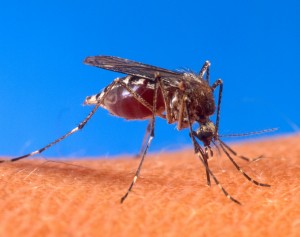
The Difference Between Bites and Stings
Invertebrates that feed on blood BITE, while invertebrates that are defending themselves, or using venom to incapacitate prey STING.
Don't get confused by the terms bite and sting. A bite usually involves mouth parts, ranging from mandibles (pincer-like mouth bits) to a big straw-like proboscis or snoot. Stings usually involve the opposite end of the invertebrate, and the abdomen. There are a few exceptions with caterpillars and other creatures whose hairs can pack a wallop.
Invertebrates that sting inject venom. Spiders that bite also use venom to incapacitate prey, so do assassin bugs, which use a toxic venom to turn their prey (other insects) into drinkable mush. Not every time that something stings you does it have to inject venom though. There are such things as dry bites and stings too.
NOTE: Creatures and plants that make you sick if you eat them are called poisonous, this is why I use the term venomous here.
Just because an insect doesn't have venom, doesn't mean it won't bite to defend itself. Many spiders are harmless, but if you really scare them or they feel afraid for their lives they will bite. The same is true for creatures like assassin bugs or wheel bugs. When threatened, they may stab you with their long proboscis but not inject venom. If you have an unknown spider in the house you can use a human spider catcher to remove it, click here.
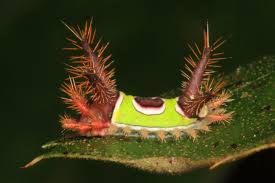
Some insects like caterpillars don't sting in the traditional sense but if you touch their envenomated spines, or their hairs, you can still have a reaction like you've been stung by a bee or wasp. Saddle-backed caterpillars (see above) have venomous urticating hairs (don't you love the big sciencey terms?), meaning they itch and sting if you tough them. Tarantulas have something similar but many of them have hairs that fall out and irritate you.
More insects bite than sting. Here is a list of terrestrial stinging , biting, and venomous invertebrates of the Eastern US:
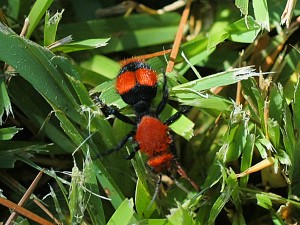
Stinging Creatures
- Hornets
- Wasps (including velvet ants, they are really wasps)
- Yellow jackets
- Ants
- Bees
- Scorpions
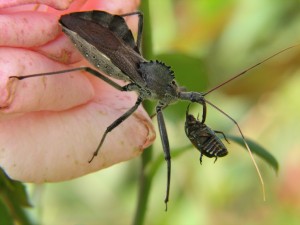
Biting Creatures
- Mosquitos
- Biting Flies
- Black Flies
- Horse Flies
- Deer Flies
- Tsetse Flies
- Sand Flies
- Biting Midges
- Assassin Bugs
- Wheel Bugs
- Dragonflies
- Fleas
- Ticks
- Bedbugs
- Lice
- Ticks
- Mites
- Chiggers
- Leeches
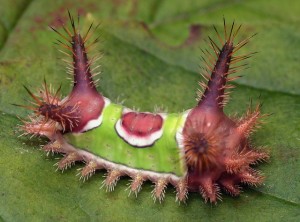
Caterpillars with Venom Glands and Hairs or Spines
- Saddleback caterpillars
- Flannel moth caterpillars
- Io moth caterpillar
- Tussock moth caterpillars
- Tent caterpillar cocoons (with poisonous powder)
This list is far from complete, but it contains the most common species you might encounter. For more on stinging caterpillars check out this paper by L.L. Hyche from Auburn University.
What Do The Bites and Stings Look Like?
Each bite and sting is unique to the creature that bites or stings you. How the stings and bites appear on your skin will vary by things like your sensitivity, how many stings or bites you received, and if you have received a dose of venom as well as how much. I'll show you some images below.
Stings
Most land based creatures that sting are in the order of Hymenoptera. The stings of ants, wasps, bee, and hornets is either for defense or for predation, and almost always comes from the creature's abdomen or rear.

Remember, they don't want to sting you! This is especially true of honey bees, that die after they sting. Some species of ant, wasp, and bee are more prone toward aggression, like Russian honey bees, velvet ants, and yellow jackets, while most are quite mild and harmless. Keep in mind that the benefits of these insects way out-strips the fact that they sting. In fact, most wasps are insect hunters and are great at eating garden and house pests!
Honey bees and bumblebees use their stingers exclusively for defense. Their stinger is a modified ovipositor (egg laying tube). Honey bees can only sting once, because the stinger is barbed and will stick in the skin or surface that is stung. Honey bees literally pull out their internal organs when they pull away from the creature being stung, and as their stinger is left behind. It's important to remember that when they do this, their venom sac and dufours (scent) gland are left behind. They are still pumping away, even though the bee has left. This is why it's important to remove the stinger immediately upon contact.
Bumblebees can sting multiple times, because their stinger is smooth, which allows it to move in and out of the creature being stung. However, like with bees, their venom is a cocktail of chemicals from the dufours gland, which includes a "scent" cue that signals "danger" and can bring more bees. This is why it's just as important to remove yourself from the area of the bee sting, as it is to remove the stinger.
If you don't believe me, that the stinger still pumps after the bee leaves, check out this video:
Bee stings hurt because there are three compounds that are mixed in the venom cocktail: Melittin, Phospholipase, and A-Hyaluronidase. These three chemicals break down cell components, disrupt biological signals (causing pain), and cause the release of hemoglobin into the blood. Bee venom is mostly protein based, while fire ant venom is about 95% alkaloid.
Wasps, some bees, and yellow jackets can also sting multiple times, and their stingers are smooth like a bumblebee. Velvet ants, also called "cow killers" are actually a type of wasp, and can sting multiple times as well.
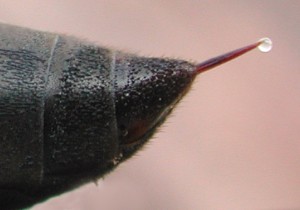
All stings cause some sort of anaphylactic reaction, how severe the reaction is depends on the conditions mentioned earlier. This reaction is essentially the body's defense mechanism, releasing histamine and other chemicals. In extreme cases airways can constrict and cause a life threatening situation. It's estimated that the lethal number of stings is approximately 20 stings per kilogram of weight.
Some of the symptoms of a sting are: swelling of the affected area, face, eyes or tongue, tenderness, pain, itching, hives, wheezing, slurred speech, nasal congestion, nausea or vomiting, difficulty breathing or swallowing, anxiety, and anxiety. Life threatening symptoms will appear within about 10 minutes after the sting.
What to look for: most bee stings appear as red swollen areas of the skin, about dime to quarter size (depending on the person), with a whitish center where the stinger went in. If a wasp or bumblebee stings you multiple times, then the area of inflammation may be larger. In some cases the center of the sting may also develop a dark dot or node.

How to Remove Stingers and Treat Stings:
- Remove stingers with a credit card, or other flat object. Do not use tweezers! Using tweezers can squeeze the venom sac at the end of the stinger and cause more envenomation. Scrape the stinger out.
- I usually use a permanent marker to circle the sting location, so that I can track the swelling of the sting over time. Permanant marker also does not wash off when you apply ice.
- Apply ice to the swollen area immediately.
- If any severe symptoms occur, seek help immediately; or if the symptoms of pain, swelling, etc. persist after several days to see a doctor.
- You can also take an antihistamine to reduce pain, or an over-the-counter painkiller to dull the ache of the sting.
- Some people carry epi-pens with them, to counter severe antihistamine reactions. To learn more about what this is check out the EpiPen page.
- Personally I like the herbal cream called "Sting Stop" to help with alleviating stings from bees and wasps. Click here to learn more.
Some Tips for Avoiding Getting Stung:
- Wear light colored clothing (to bees and wasps you look like a big bear or predator if you're in dark colors; this is why bee keepers wear white).
- Avoid shampoos and body products that smell floral.
- Stay calm and move slowly around bees and wasps, do not swat and flail!
- Run to a safe area in a straight line, and try to find a sealed location where the insects can't gain access. DO NOT RUN TOWARDS OTHER PEOPLE.
- Don't take your clothes off, this just opens up more places of sensitive skin to be stung.
- Don't use loud equipment around hives (lawn mowers, weed eaters, stereos, etc.).
- Wear a long sleeved shirt and pants.
- Tuck pants into socks.
- Avoid sweet drinks such as sodas, and areas where sweet things are disposed of, like trash cans.
- Check out my previous blog post on how to recognize wasp and yellow jacket nests.
Bites
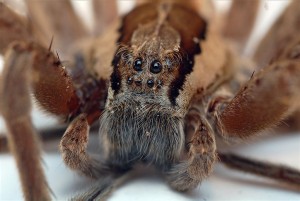
Bites occur because animals need to feed, and often for defensive reasons. All bites come from the mouth parts of the animals, which can be mandibles or a proboscis. Invertebrate bites can vary from the single "poke" by a mosquito, to the double fang bite of a spider. Bites do not always involve the injection of venom, like with spiders. There may be other chemicals in the saliva or mouth parts of the organism that can cause a painful reaction, like the saliva of mosquitos or ticks. There are many different types and styles of bites, depending on the creatures. Here I'll cover some of the more common you may encounter.
Spider Bites
In North America there are really only two spiders you need to worry about biting you, brown recluses and black widows. If you're not sure how to tell brown spiders apart, then check out my previous blog posts on identifying brown spiders or black widows. You can also purchase a guide to help you ID what you have around the house, click here for the Golden Guide or click here for the professional guide.
Almost all spiders can bite, but they are very, very, very afraid of humans, and in most cases their fangs are so tiny you wouldn't even feel it if they did bite. Additionally, almost all spider bites are harmless. So, take a deep breath. If you think you've been bitten by a spider be sure that it's not a sting or bite from another creature first.
Here's a picture of a spider bite.
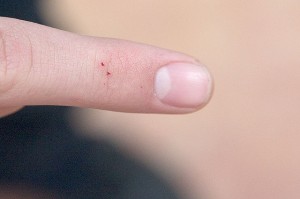
Symptoms of Spider Bites:
Black widow bites can be serious, but they are rarely lethal, and usually no worse than a bee sting. Look for a swollen and red area, chills, fever, abdominal pain, nausea, anaphylaxis, shortness of breath, headache, and vomiting.
Brown recluse bites include the same symptoms, though most people report they are painless. The bites may cause a rash, mild fever, or listlessness. In rare cases, tissue damage may occur from a brown recluse bite bite, with necrosis or tissue death occurring, usually between 12-96 days later. This is caused by an enzyme in the venom of the spider that breaks down cell membranes. There is no confirmed way to stop the necrosis, it must be left to spread until it stops and begins to heal. This may take weeks. I would emphasize that this is rare. Deaths from brown recluse are only reported from children younger than 7 years of age.
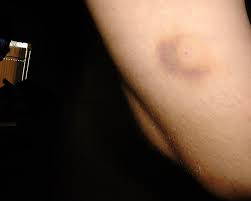
Brown recluse spider bites are extremely rare, as is seeing just one. They tend to gather in large groups where they are endemic, and not all are large enough to envenomate. Rarely do they travel in "singles." So if you think you've been bitten by one, look in the immediate area, there should be more. Check out this paper by "Rick Vetter, from UC Riverside at the University of California. He goes into great detail about over diagnosis of brown recluse bites.
What to Look For
If you think you have been bitten, look for one or two small fang marks, usually with some localized redness and swelling. In the case of the brown recluse you might also begin to see necrosis after 12 hours, but it is very rare. Sometimes the bite site may become firm to touch. If necrosis does occur, it may begin with blistering, a bluish tint, and a necrotic, blackish spot where the tissue begins to die. As with all bites and stings, I like to circle them with permanent marker to keep track of how they swell or spread.
Treatment of Spider Bites
- Remain calm, you don't want to increase circulation of blood flow and venom.
- Apply a cool cloth and ice.
- Do not apply a tourniquet.
- If you can safely catch the spider, try to do so, for the doctor or physician.
- You can take local pain relievers and antihistamines such as Benadryl to relive pain and itching.
- I like the herbal cream called "Sting Stop" to help with alleviating stings from bees and wasps but it also helps with general bites from other creatures. Click here to learn more.
Mosquito Bites
Only female mosquitoes feed on blood meals, so don't blame the males. Female mosquitos find you by detecting the carbon dioxide you exhale, as well as your body heat. They can even detect lactic acid, so if you're working out you are extra vulnerable!
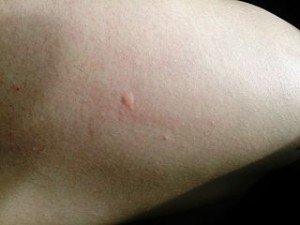
When a mosquito bites you it uses it hollow snout-like proboscis, which is actually quite flexible, and contains two tubes. The mouth parts can slide into the skin and actually "probe" around until it finds a blood vessel to suck on. They can sense the differences between tissue and blood vessels with their snouts.
Here's a fascinating video showing a probing mosquito proboscis:
One part of their complex snout is a tube that secretes saliva on you, the other is a "drinking straw." Their saliva has a chemical that acts like an anesthetic, so you don't feel them "probing" around. They also have serrated mandibles that go to work probing around and tearing up tissue to help make you bleed, while looking for your veins. These little blood suckers are also amazing because they can both suck blood and spit anesthesia at the same time! If they hit a nice vein, then their saliva tube begins to secrete more chemicals, namely a vasodialator (which causes your blood vessels to dilate, and the blood to flow more freely) and an anticoagulant that keeps your blood from clotting. It's during this "injection" that parasites in the mosquito's saliva get passed on to humans, like malaria.
What to Look For in Mosquito Bites
Reaction to mosquito bites varies from person to person, and it also depends on your age and exposure.
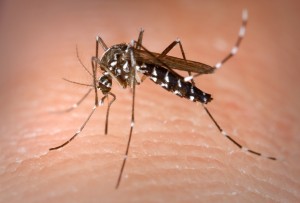
The best explanation I found comes from David Ropeik from the Harvard Center for Risk Analysis:
"The immune system releases histamines, chemicals that make the cells in the lining of our blood vessels spread apart. That lets fluid leak out into the skin. That fluid is carrying components of our immune system that attack and destroy the foreign chemicals from the mosquito. The extra fluid from the leaking blood vessels causes a bump, which irritates other receptors in the skin, leading to the itching. After we’ve been bitten enough, and after our immune systems have matured a bit more, we have a different reaction to mosquito saliva. Instead of triggering histamines, another part of the immune system grabs onto the foreign chemicals and drags them away to macrophages, which are like microscopic garbage disposers in our bloodstream. They chew up and destroy the “Jus de Mosquito.” If you’re bitten enough, like the mosquito lab people who have figured all this out, you stop developing bumps and itching completely. Kids get bigger bumps from mosquito bites than adults because their immature immune systems respond with larger amounts of histamines. More leaking blood vessels equal bigger bumps, equal more itching and scratching."Treatment for Mosquito Bites
Treatment for mosquito bites is about the same as for other bites and stings, ice, or cool cloths, antihistamine, and/or anit-itch medication. As an aside, I find that mud applied to bites and stings helps to take out the itch and sting too!
This blog post has gotten quite long, and as you can tell, there's a lot to know about bites and stings, all of which can be very "creature" specific. I'll cover ticks, chiggers, and wheel bugs in another post, but for now this is a good start, and remember, precaution, common sense, insect repellent, and a healthy respect for our invertebrate friends is always a good idea.
Resources you can check out:
- https://beespotter.mste.illinois.edu/topics/stings/#Bee_Sting_Treatment (info on bee and bee stings)
- https://www.emedicinehealth.com/wilderness_black_widow_and_recluse_spider_bite/article_em.htm (great info on black widow and brown recluse bites).

